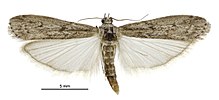
Ephestia kuehniella

The Mediterranean flour moth or mill moth (Ephestia kuehniella) is a moth of the family Pyralidae. It is a common pest of cereal grains, especially flour. This moth is found throughout the world, especially in countries with temperate climates. It prefers warm temperatures for more rapid development, but it can survive a wide range of temperatures. The Mediterranean flour moth is frequently found in warm places with stored grain products, such as flour mills and bakeries, where it can breed year round. Flour mills have a particular problem with the Mediterranean flour moth because the caterpillars spin silk that clogs machinery. The most effective pest control strategy for this moth is sanitation of facilities and sealing grain containers to prevent infestation, but some pesticides may also be used. Adult Mediterranean flour moths have pale gray bodies. Their forewings are gray with black zigzag markings while the hindwings are an off-white color. The wingspan is 1.5-2.6 cm. Larvae (caterpillars) are white or pink with black spots and dark heads. Pupae are reddish brown. First recorded as a pest species in Germany in 1879, the Mediterranean flour moth was found in several locations across Europe in subsequent years. In the late 19th century, roller flour mills caused the moth to become a more widespread pest. It became a common species in Britain, North America, and Australia by 1980. The Mediterranean flour moth is now found throughout the world, though it tends to be rare in the Far East with the exception of Japan. Areas of the world with temperate climates are most likely to have infestations of the Mediterranean flour moth in their flour mills. Mediterranean flour moths live in stored grain products. They primarily infest flour, but they can be found in a variety of cereal grains. The moth is a major pest species in flour mills, and it may also be found in bakeries and warehouses, especially in cereal products that have been left undisturbed for an extended period of time. This species particularly enjoys inhabiting flour mills and bakeries due to the heat, which allows it to breed year round. Caterpillars feed on flour, meal, whole grains, and grain residues. Unlike other pest species of moths, E. kuehniella is almost always found in cereal grain products as opposed to other stored foods such as dried fruit. Adult Mediterranean flour moths are short-lived and do not feed. E. kuehniella females typically oviposit on the second night after emergence. This is because they require a few hours for the sperm to move from the bursa copulatrix to the vestibulum, where fertilization occurs. Females will then lay anywhere between 116 and 678 eggs in a food source, such as flour, to which the eggs often become attached. When the eggs hatch, larvae spin silken tubes around themselves. They spend about 40 days maturing within these tubes. Full grown larvae disperse to new locations and spin silken cocoons in which they develop into pupae. Adult moths emerge in 8–12 days. In hot weather, the moth's entire life cycle may take no more than five to seven weeks. Though it prefers warm temperatures because it can develop more rapidly, E. kuehniella can complete development in temperatures ranging from 12 °C to about 30 °C.
